Working Pointer Tells it as it is.
We have managed to get a rare interview with a working pointer, which gives a dog’s insight into the trials and tribulations of working with the wind:
Journalist: I hear your name is Gollum. Is that your real name and are you pedigree?
Gollum: My real name is Trudvang Faurbauste and I am a German Wirehaired Pointer.
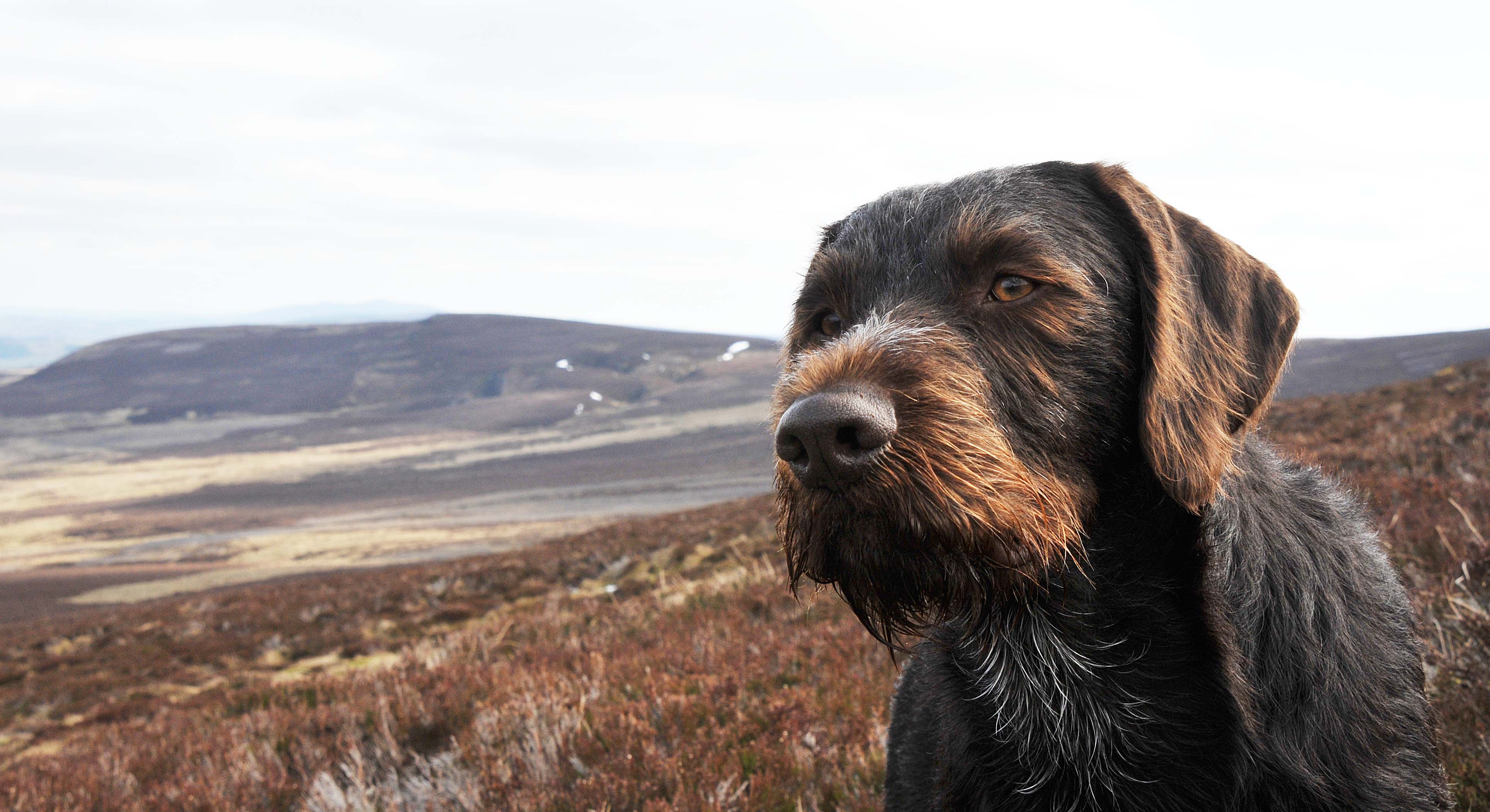
Journalist: What line of work are you in?
Gollum: I am a professional pointer, a HPR, which means that I can both Hunt, Point and Retrieve. I work mainly on grouse in Scotland, but I am also hired for pheasant, snipe, woodcock and partridge. I also do a bit of dog bed modelling when my coat is nice.
Journalist: What do you find the most challenging part of your job?
Gollum: As I am hired for my nose and my stamina the wind is my main tool. When the moor has a steady, warm breeze over it, pointing is quite easy. I just take a line across the wind and pick up any scent of birds. As I detect just the slightest scent, I hesitate, investigate and if it’s positive, I start moving in carefully till I come to a place where I am certain that I have the birds in front of me. This is the moment to stop and be absolutely still and on point, otherwise the birds might lift.
Challenging days are when the wind is either still or very strong and blustery. Also, it can be difficult to run on a moor with many hills and deep glens. Here you can have the wind perfectly in your face, but as you dip down between two hills, the wind can suddenly be coming from a completely different direction. This can cause me to miss birds or, worse, bump into them. Humans don’t always seem to appreciate this and we, pointers, are seen as making mistakes when we could not have known.
Very windy, blustery conditions can also be challenging as the scent seems to be scattered so fast that I can lose where exactly it originates.
As I need the wind to work, it can also be extremely difficult to work if it is a very quiet day. With no wind it is impossible to get into a rhythm and to find a direction. There is simply no way of running across the wind. When conditions are like that, you have to be very careful and not run too fast as you are suddenly ON the birds. It is very easy to end up bumping birds as you are too close by the time you detect their presence. Furthermore, the shooting party is also already getting extremely irritated because they are being eaten up by midges. Luckily we do not see many still days in Scotland, where I do all my work.
Journalist: When do you find that the scent goes away?
Gollum: Well, hahaha…. the humans always speculate and guess about this. There are certain conditions where the scent can be very tricky, but sometimes the wind is just not in my favour and the humans start claiming that “it’s a bad day for scent”.
Certainly, if you get cold rain, it can subdue the scent greatly. Recently we were out on grouse in August. We had driven quite high up a track in the cars and from here set out in the Argo Cat. As we had just arrived at the moor where I was going to work, we were overcome by a freezing cold shower of rain and hailstones. We all huddled in under the Argo till the rain went off. Well, what a disaster. I started running across the wind and missed everything. Even the guns were kicking up birds around them in places where I had been and not detected any scent. It was extremely embarrassing. However, it only took 10-15 minutes before the ground started to heat up and I was able to point again, no problem at all.
The other extreme can be really hot days where my tongue is hanging out as far as it can go and my nose is full of pollen. I am hot and bothered and constantly thirsty. Then it is very difficult to get the scent as I run from one cooling water-puddle to another.
Journalist: Do you find it hard to work the back wind instead of running in to the wind?
Gollum: It is definitely more difficult and you have to know what you are doing. The guns also have to understand the concept of back wind. The best way to do it is for me to run straight out in front of the guns, then turn and work that piece of ground back to the guns, now into the wind for a little bit. I risk bumping birds on the way out, but it can’t be otherwise. As I hunt back towards the guns and if I find birds, they are then faced with me on point, facing them as in the picture below.
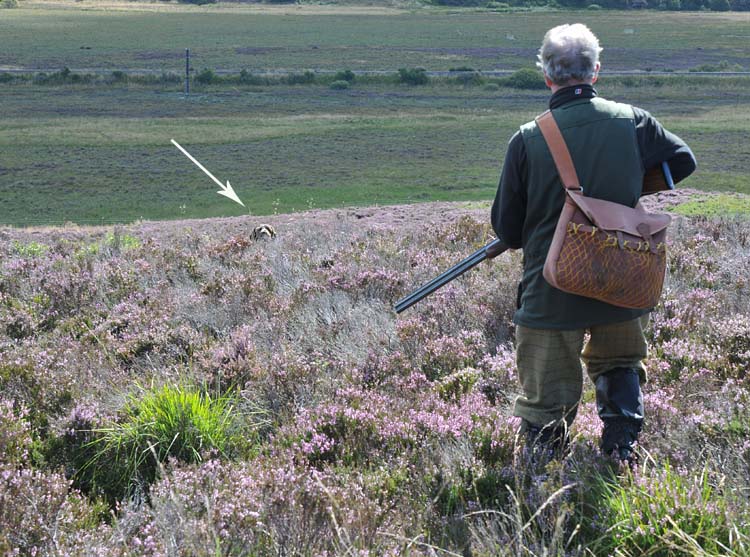
My master can take the whole party right round and walk up behind me, which she sometimes does for safety (my safety!), but if the guns understand, they can walk towards me and shoot as the birds get up between them and me. In the picture below is my colleague, Tippex, has flushed the birds and is now sitting down waiting to mark the birds for the retrieve.
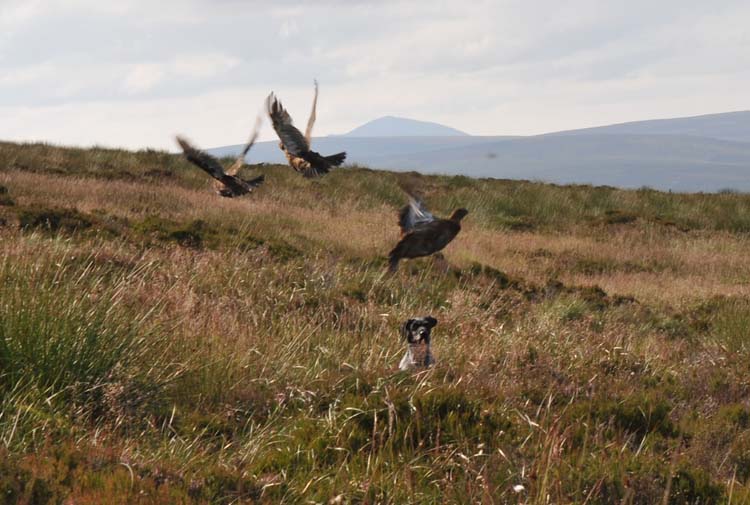
Luckily we have not had any accidents and hopefully it will remain that way. My master always seems very nervous when they shoot towards me…
Journalist: Do the birds not tend to just run sometimes?
Gollum: Pheasants are quite bad at that, but you can have problems with grouse as well. The classic example is a single grouse cock. I sometimes point the scent and the guns join me, ready, but then I realise that the scent is maybe further along and I move on and point. Then again I find the scent is moving and it’s a stop-start game on and on for sometimes maybe 150 meters or more. It is really my master’s job to make sure that the guns keep walking with me till the bird gets up. If they are not experienced, they don’t keep faith that I will produce a bird and they lose interest and fall behind usually JUST at the moment where I find the bird. There is a general agreement that it is good to kill the old cock birds as they will not produce new brood, but will hold on to a territory that could have been used by a productive pair.
Running birds also happen on very windy days or on ground where there has been a lot of human activity. The birds sit up and look out all the time. Some say that because it’s windy, they can’t rely on their hearing, so they look out. Often they will sit while the dog points, but start to walk and run when humans appear as they seem enormous against the sky (from the grouse’s viewpoint). Below is my other colleague, Alice, on point on a whole group of grouse that is running along. To get them, you kind of need to stalk up to them. I get very unpopular if I move as well because that is almost certain to get them on the wing prematurely.
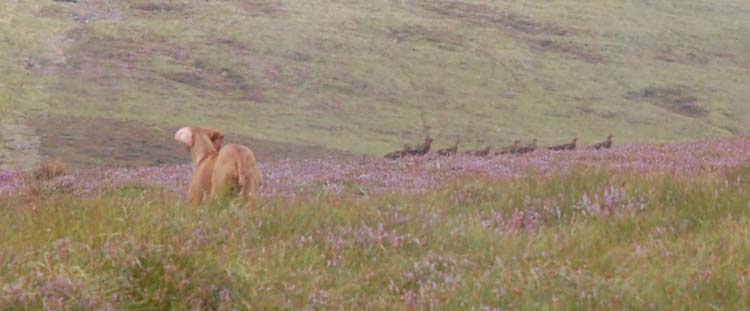
The opposite can also be a problem: when the birds sit too tight. It’s almost impossible for me to resist grabbing them if they sit right under my nose. If I do peg one, oh my God I am not popular. “Un-sporty” apparently…..
Journalist: Do you make mistakes some times?
Gollum: Oh yes!!! Come on, even the best makes mistakes and it’s fully accepted by master and guns. But a whole lot of mistakes in one day is NOT good. We were out three days ago and the wind must have been around 40mph with huge gusts. None of us could get to grips with the scent at all. We were bumping birds and also pointing convincingly on empty places where the birds had been sitting a while ago. Most annoying.
I also did make an embarrassing mistake a couple of years ago: as I was hunting systematically, I got the hint of something and was convinced it was a bird. I picked it up and proudly brought it to my master. Everyone laughed as it turned out to be a red leather glove that somebody had dropped on the moor ages ago. They all just thought I was cute and put it in the bag as “other”.
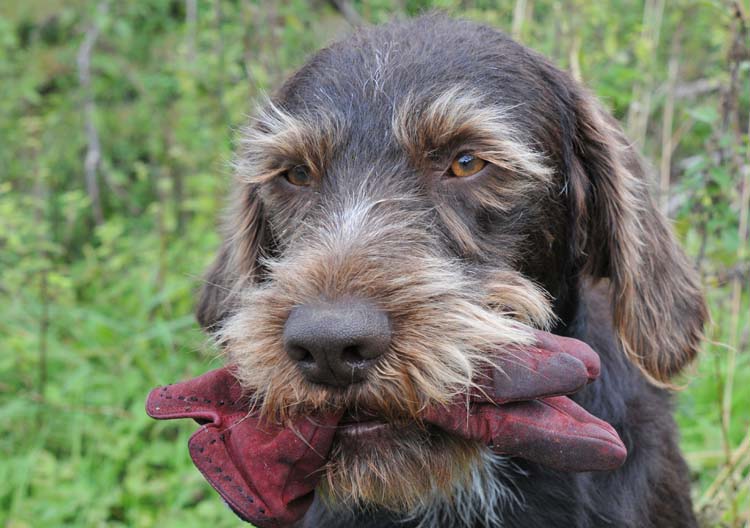
Journalist: You seem to enjoy your job?
Gollum: Absolutely! I am bred for it, they say, and I just LOVE the journey out in the morning, meeting all my friends and colleagues and all the humans. We run and work all day and it’s an absolute thrill. Then, after a long day with plenty of biscuits at lunch time and water during the day, we all lie on our big dog bed in the back of my master’s truck and chill out on the way home.
-
12/08/2012 17:24
Glorious 12th
I am writing this while Gollum and the others are munching through huge pieces of tripe in the garden. It is of course the Glorious 12th (and overcast!), but it's Sunday, so the day is deferred till tomorrow, where a ver.. -
10/10/2012 14:29
Pick of the Litter
The time has come to get the next generation going. Alice is nearly 10, Tippex is 7 and Gollum is three years old. Getting a new puppy is essential now in order to be ready for work in a couple of years when Alice is too..



